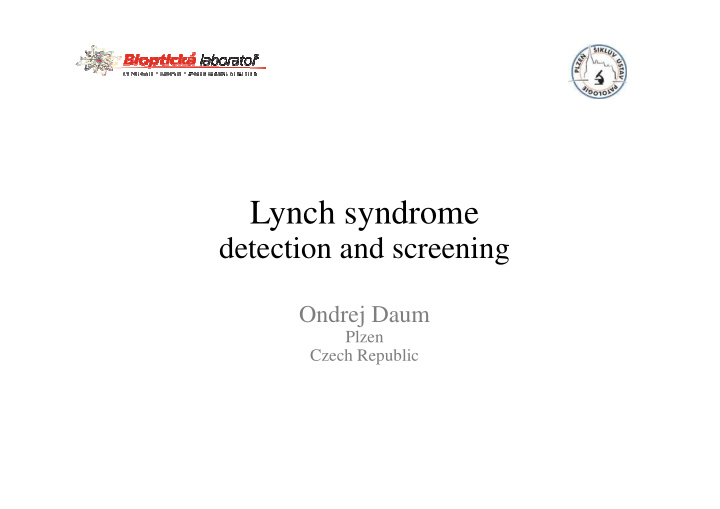



Lynch syndrome detection and screening Ondrej Daum Plzen Czech Republic
Χ Pai R. K. et al. (2016) Am J Surg Pathol 40(4): e17-34 Pai R. K. et al. (2016) Am J Surg Pathol 40(4): e17-34 1 out of 440 people carries a germline mutation causing LS (i. e. 22 730 in Czech Republic) Localisation Cancer risk large intestine up to 74 % small intestine up to 12 % stomach up to 13 % uterus up to 71 % fallopian tube/ovary up to 20 % urinary system up to 25 % • adenoma to carcinoma transformation occurs in 2-3 years (x 8-10 years in sporadic CRC) • average age at the time of diagnosis is 45 let (x 65 years in sporadic CRC)
Mismatch • 15 % CRC are MSI-H • 20 % MSI-H CRC are caused by LS MSH6 Germline “loss of Germline “loss of DNA function” mutation of function” mutation of MSH2 an MMR gene an MMR gene MLH1 PMS2 Lynch Repair Sporadic Epigenetic inactivation of Epigenetic inactivation of MSI-H MLH1 MLH1 CRC (promoter hypermethylation) (promoter hypermethylation) Peltomaki P. et al. (1993) Cancer Res 53(24): 5853-5855 Peltomaki P. et al. (1993) Cancer Res 53(24): 5853-5855 Yuen S.T.et al. (2002) Oncogene 21(49): 7585-7592 Yuen S.T.et al. (2002) Oncogene 21(49): 7585-7592
Possibilities of detection Molecular genetic testing of all CRC 1. and endometrial ca. for MMR mutations? MSI testing of all CRC 2. and endometrial ca.? IHC MMR staining of all CRC 3. and endometrial ca.?
4. • MSI-H histology is more sensitive than the combination of 4 remaining RBG criteria
MSI-H histology (SemiPREDICT score) MSI - feature • Pro č to vadí? Right-sided localisation Dissecting mucin (any volume) Age < 50 years TILs (> 2/HPF or > 10/100 epithelial nuclei) Peritumoral lymphoid cuff Stromal plasma cells (> 25% stromal leukocytes) If ≥ 2 signs → MSI susp. Hyde A. et al. (2010) Am J Surg Pathol 34(12):1820-1829 Hyde A. et al. (2010) Am J Surg Pathol 34(12):1820-1829
IHC deficiency of * Not applicable in EC IHC deficiency of MLH1 and/or PMS2 MSH2 and/or MSH6 + Semi PREDICT IHC: - + score ≥ 2 BRAF V600E Annexin A10 * - IHC MMR + - def. BRAF V600E * - Analysis of + MLH1 and PMS2 Hypermethyl. MLH1 - in peripheral blood - + mut ? wt MSI-H LS Analysis of Finish MSH2 , MSH6 and EPCAM testing in peripheral blood mut Lynch like syndrome wt LS Clinical suspicion
Timeline of LS detection in Plzen Investigation * almost completely All CRCs and ECs to banned by clients investigate by IHC of PBL Only clinical geneticists can No blood received order germline for germline testing testing 2013 2014 2015 2016 2017 SemiPREDICT score IHC on all CRCs and ECs in the Sikl´s Institute (**), while only on investigated by all consult cases in the private Bioptical Laboratory ↓ pathologists in the Sikl´s Institute and in the private In case of LS suspicion the patient´s GP is contacted by phone and Bioptical Laboratory asked to refer the patient to clinical geneticist ↓ Positive cases sent to me for * Reason shown later further management ↓ ** • In CRC resection specimens one extra tissue block submitted for Comment on LS suspicion IHC during gross specimen processing, in endoscopical biopsies along with request on blood the IHC performed as a second step in the report • In EC the IHC performed as a second step
2013 PBL SI CRC 1006 376 MSI-histology 47 (4.7 %) 40 (10.6 %) LS 3 (0.3 %) 4 (1.06 %) Not Finished (NF) 6 1 LS + NF 9 (0.89 %) 5 (1.32 %) Results 2013-2016 CRC 20 endometrium 2 duodenum 1 LS frequency reaches 1.2 % (or 2.4 % for LS+NF)
Possible explanations of the low percentage 1. Statistical effect of “low numbers” 2. Regional differences of distribution (environmental factors) 3. IHC-related errors
Recommendations • Centralize the detection of suspicious cases • Choose a powerful but (relatively) cheap method of detection of suspicious cases (IHC) • Build a stable team: • Pathologist • Molecular geneticist • Clinical geneticist • Gastroenterologist • Gynecologist • Urologist • Dermatologist • Create an encrypted network software to share the data within the team • Persuade health maintenance organization (health insurance company) • Persuade politicians • Be patient!
… or authorize someone else to organize the screening … … and to become frustrated.
Recommend
More recommend